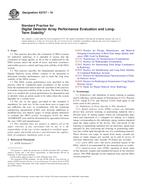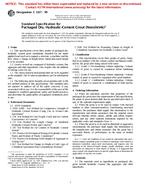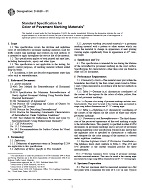1.1 These test methods cover procedures for the chemical, mass spectrometric, and spectrochemical analysis of nuclear-grade boron carbide powder and pellets to determine compliance with specifications.
1.2 The analytical procedures appear in the following order:
| Sections | |
| Total Carbon by Combustion in an Inductive Furnace and Infrared Measurement | 7-16 |
| Total Boron by Titrimetry and ICP OES | 17-27 |
| Isotopic Composition by Mass Spectrometry | 28-32 |
| Pyrohydrolysis | 33-40 |
| Chloride by Constant-Current Coulometry | 41-49 |
| Chloride and Fluoride by Ion-Selective Electrode | 50-58 |
| Water by Constant-Voltage Coulometry and Weight Loss on Drying | 59-62 |
| Metallic Impurities | 63 and 64 |
| Soluble Boron by Titrimetry and ICP OES | 65-79 |
| Free Carbon by a Coulometric Method | 80-89 |
7.1 This method covers the determination of total carbon in nuclear-grade boron carbide in either powder or pellet form.
17.1 This method covers the determination of total boron in samples of boron carbide powder and pellets by titrimetry and ICP OES. The recommended amount of boron for each titration is 100 ± 10 mg.
28.1 This method covers the determination of the isotopic composition of boron in nuclear-grade boron carbide, in powder and pellet form, containing natural to highly enriched boron.
33.1 This method covers the separation of up to 100 μg of halides per gram of boron carbide. The separated halides are measured using other methods found in this standard. It also covers the sample preparation for the determination of isotopic composition by ICP MS.
41.1 This method covers the measurement of chloride after separation from boron carbide by pyrohydrolysis. The lower limit of the method is about 2 μg of chloride per titration.
50.1 This method covers the measurement of chloride and fluoride after separation from boron carbide by pyrohydrolysis. The limit of detection for chloride and fluoride in the boron carbide sample is 3 mg/kg and 2 mg/kg, respectively.
60.1 This method covers the determination of water in boron carbide in either powder or pellet form. The lower limit of the method is 5 μg of water. The lower limit of the weight loss on drying method is 20 mg/kg for a sample mass of 5 g.
65.1 This method covers the determination of soluble boron in boron carbide. Soluble boron is defined as that boron dissolved under the conditions of the test.
80.1 This method covers the determination of free carbon (also called soluble carbon) in boron carbide powders and shaped or sintered bodies of boron carbide after crushing. This method is applicable to mass fractions of free carbon of 0.01 % to 10 %.
Product Details
- Published:
- 07/01/2011
- Number of Pages:
- 25
- File Size:
- 1 file , 390 KB


